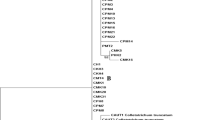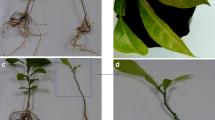Abstract
Chilli (Capsicum annuum) fruits showing symptoms of an-thracnose disease were collected from farmer’s fields in different chilli-growing areas of Tamil Nadu, India, and fungal pathogens were isolated from the infected fruits. The isolates were identified as Colletotrichum capsici, C. gloeosporioides and Alternaria alternata, based on morphological and cultural characters. Colletotrichum capsici was the most commonly isolated fungal species from infected chilli fruits. The virulence of all the fungal isolates was determined in vitro by artificial inoculation on detached chilli fruits (cv. K2). The measurement of disease severity of chilli revealed differences in the virulence between isolates. The molecular variability among isolates of C. capsici that differed in virulence was analysed by means of random amplified polymorphic DNA (RAPD), using 22 random primers. Analysis of the genetic coefficient matrix derived from the scores of RAPD profile showed that minimum and maximum per cent similarities among the C. capsici were in the range of 16 to 81% respectively. Cluster analysis, using the unweighted pair-group method with arithmetic average (UPGMA), clearly separated the isolates into three clusters (I, II and III), confirming the genetic diversity among the isolates of C. capsici from chilli. Cluster III consisted of only one isolate (CBE1), cluster II consisted of two isolates (TEN 3 and TEN 4) and all the remaining isolates belonged to cluster I. No relationship between clustering in the dendrograms and virulence of C. capsici isolates was observed.
Similar content being viewed by others
References
Bosland PW & Votava EJ, 2003. Peppers: vegetable and spice capsicums. CAB International, England p. 233.
Hadden JF & Black LL, 1989. Anthracnose of pepper caused by Colletotrichum spp. Proceeding of the International Symposium on Integrated Management Practices: Tomato and Pepper Production in the Tropics. Asian Vegetable Research and Development Centre, Taiwan, 189–199.
Harp TL, Pernezny K, Lewis Ivey ML, Miller SA, Kuhn PJ & Datnoff L, 2008. The etiology of recent pepper anthracnose outbreaks in Florida. Crop Protect 27, 1380–1384.
Kim BS, Park HK & Lee WS, 1989. Resistance to anthracnose (Colletotrichum spp.) in pepper. In: Proceedings of the International symposium on Integrated Management practices: Tomato and Pepper production in the Tropics, AVRDC, Taiwan. 184–188.
Kim KK, Yoon JB, Park HG, Park EW & Kim YH, 2004. Structural modifications and programmed cell death of chilli pepper fruits related to resistance responses to Colletotrichum gloeosporioides infection. Phytopathology 94, 1295–1304.
Mistry DS, Sharma IP & Patel ST, 2008. Biochemical parameters of chilli fruits as influenced by Colletotrichum capsici (Sydow) Butler and Bisby infection. Karnataka J Agric Sci 21, 586–587.
Montri P, Taylor PWJ & Mongkolporn O, 2009. Pathotypes of Colletotrichum capsici the causal agent of chili anthracnose in Thailand. Plant Dis 93, 17–20.
Murray MG & Thompson WF, 1980. Rapid isolation of high molecular weight plant DNA. Nucleic Acids Res 8, 4321.
Ratanacherdchai K, Wang HK, Lin FC & Soytong K, 2007. R APD analysis of Colletotrichum species causing chilli anthracnose disease in Thailand. J Agri Technol 3, 211–219.
Ratanacherdchai K, Wang HK, Lin FC & Soytong K, 2010. ISSR for comparison of cross-inoculation potential of Colletotrichum capsici causing chilli anthracnose. African J Micro Res 4, 76–83.
Rohlf FJ, 1990. NTSYS-pc. Numerical Taxonomy and Multi-variate Analysis System, Version 2.02. New York, Exeter soft-ware.
Sharma PN, Kaur M, Sharma OP, Sharma P & Pathania A, 2005. Morphological, pathological and molecular variability in Colletotrichum capsici, the cause of fruit rot of chillies in the subtropical region of north-western India. J Phytopathol 153, 232–237.
Than PP, Jeewon R, Hyde KD, Pongsupasamit S, Mongkolporn O & Taylor PWJ, 2008a. Characterization and pathogenicity of Colletotrichum species associated with anthracnose disease on chilli (Capsicum spp.) in Thailand. Plant Pathol 57, 562–572.
Than PP, Prihastuti H, Phoulivong S, Taylor PWJ & Hyde D, 2008b. Chilli anthracnose disease caused by Colletotrichum species. J Zhejiang Univ Sci 9, 764–778.
Author information
Authors and Affiliations
Corresponding author
Rights and permissions
About this article
Cite this article
Madhavan, S., Paranidharan, V. & Velazhahan, R. RAPD and virulence analyses of Colletotrichum capski isolates from chilli (Capsicum annuum). J Plant Dis Prot 117, 253–257 (2010). https://doi.org/10.1007/BF03356370
Received:
Accepted:
Published:
Issue Date:
DOI: https://doi.org/10.1007/BF03356370




